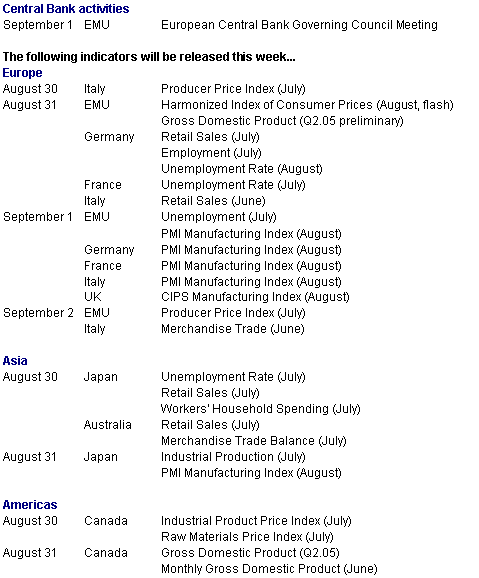Monday, August 29, 2005

Global Markets
Equities drifted mostly lower on a sea of higher oil prices and traditional light summer volume with few economic data points to lead the way. As the last full week of summer approaches, market players will be relieved to see a return of vacationing investors and a pick up in new economic information. Global equity markets have struggled to break free from the oppressive influence of record high oil prices as new worries surfaced about their potential to hurt corporate profits and consumer spending. Analysts fretted that $70 barrel oil was uncomfortably close to becoming a reality. The fact that the futures market is currently pricing in oil above $60 a barrel for the next five years added to investor concerns because it suggests that high prices will be more than a temporary phenomenon.

With three trading days left in August, it appears that global equity markets have paused after recording strong increases between April and July. In the last two weeks, markets have dithered again about oil, after having previously taken a very benign view about its impact on growth and inflation. Stocks in Japan were buoyed by positive growth prospects and higher approval ratings for Prime Minister Junichiro Koizumi prior to the September 11th special election.
Global Stock Market Recap

Europe and Britain
Equity markets remained subdued amid conflicting economic signals from both sides of the Atlantic. After hitting their peaks on August 10th, equities were buffeted by thin volumes that magnified every move. An unexpected worsening of German business sentiment helped dampen traders' spirits last week. The Ifo index was unexpectedly lower. This contradicted expectations of a higher reading after the ZEW hit a 17-month high earlier in the week. And although Friday began positively, investors reversed direction after the U.S. University of Michigan sentiment survey declined more than expected and oil prices stubbornly stayed around $67. On the week, the FTSE, CAC and DAX were down. It was the second negative week for the FTSE and DAX.

Asia/Pacific
Stock indexes have been rocky in Asia/Pacific as well. Only those in Japan experienced a second week of fairly solid gains. The STI stayed about even on the week while the all ordinaries, Kospi and Hang Seng all dipped for the second week. Concerns about the impact of oil prices on consumer spending and profits surfaced again. The little U.S. data that were available contradicted and only confused investors.

Japanese stocks were up for the third week thanks to foreign investors. Foreign investors appear to be taking an upbeat view of the national elections called for September 11th by Prime Minister Junichiro Koizumi after the failure to pass a postal privatization bill in parliament. Recent growth in foreign investment inflows had been driven by increased confidence that domestic demand was improving on a sustainable basis at long last. This confidence had been reinforced by improvements in both corporate profitability and labor market conditions. Foreign investment in Japanese equities climbed to the highest weekly level since March 2004 on growing optimism over the prospects of the country's economic recovery and the outcome of impending national elections. Foreigners were net buyers of Japanese shares for the ninth successive week, making net purchases of ¥721.9 billion. Over the nine weeks, net purchases amounted to more than ¥3,000 billion ($24.37 billion).
Currencies
The yen benefited from surging Japanese equity markets and renewed confidence that Prime Minister Junichiro Koizumi would be returned to office in September's snap election. A recent poll said that Koizumi's approval rating had risen to 53.2 percent from 47.7 percent, helping damp fears of political uncertainty after the election. Also contributing to yen strength has been growing optimism about growth. The yen strengthened early last week as reports showed international investors were net buyers of Japanese stocks for a 10th consecutive week and the trade surplus shrank less than expected. Koizumi is seeking a mandate to continue policies that have brought Japan out of recession.

Despite mixed economic news, the euro was up on the week. The dollar was weakened by the University of Michigan survey that showed U.S. consumer confidence was down more than expected. The survey added to investor concerns that higher oil prices would curb economic growth. This added to worries expressed earlier in the week, after a report on durable goods orders dropped more than expected. The dollar trimmed some of its losses after Fed Chairman Alan Greenspan gave what was deemed a hawkish speech Friday morning. It inferred that the Fed would continue to increase interest rates from their current 3.5 percent level.
Financial markets are closed on Monday August 29th in London, the world's largest currency trading center.
Indicator scoreboard - August 15 through August 26
EMU - July unadjusted harmonized index of consumer prices was down 0.2 percent and up 2.1 percent when compared with last year. HICP excluding energy, food, alcohol and tobacco was down 0.3 percent and up 1.3 percent on the year. HICP excluding energy and unprocessed food - the ECB's preferred core measure - was down 0.3 percent and was up 1.4 percent on the year. Transport fuel prices were up 3.9 percent and package holiday prices were up 7.7 percent on the month. However, garment prices sank by 7.2 percent, footwear prices were down 6.4 percent and fruit prices were down 4.5 percent.

June industrial output was up 0.3 percent and 0.3 percent when compared with last year. Output declined for intermediate goods and nondurable consumer goods but was up for energy and durable consumer goods.

June unadjusted merchandise trade surplus was €6.4 billion, up from May's €2.7 billion surplus. Exports were up 7.1 percent while imports were up 3.5 percent on the month. On the year, exports were up 6.7 percent while imports were up 9.3 percent. Seasonally adjusted merchandise trade paints a different picture. The June surplus was €3.4 billion, down from €4.2 billion in May. Seasonally adjusted exports were down 0.5 percent while imports were up 0.3 percent on the month.

M3 money supply for the three months ending in July was up 7.6 percent when compared with the same three months a year earlier. This is well above the ECB's money supply growth target of 4.5 percent.

Germany - July producer price index was up 0.5 percent and 4.6 percent when compared with July of 2004. Excluding energy, the PPI was down 0.2 percent and up 1.4 percent on the year. Energy prices were up 2.9 percent while basic goods prices were down 0.3 percent and investment goods prices slipped 0.1 percent on the month.

August ZEW expectations index jumped 13 points to 50 from July's reading of 37. The current conditions index improved to minus 66.7 from minus 70 thanks to improving industrial production. The ZEW surveyed 322 German financial experts for their views between August 1st and August 22nd.

Second quarter gross domestic product was flat and up 0.6 percent when compared with last year. Domestic demand was up 0.3 percent after dropping 0.4 percent in the first quarter thanks to government spending combined with inventory accumulation. However private consumption was down for the second quarter in a row. Gross capital investment managed a 0.2 percent increase after sinking for two consecutive quarters. Equipment investment was up but construction investment continued to decline.

August Ifo business sentiment index drifted down to 94.6 from 95 in July. Current business conditions reading was down to 93.8 from 94.9 while future expectations edged upward to 95.4 from 95.1 in the previous month. Sentiment dropped in manufacturing, wholesale and retail sectors while construction sentiment was up.

France - June seasonally adjusted merchandise trade deficit expanded to €1.2 billion from May's deficit of €1.1 billion. Exports dropped 2.8 percent while imports were down 2.5 percent. Exports to other EU countries were slightly higher but were down to the U.S., Africa and the Middle East.

Second quarter gross domestic product edged up 0.1 percent and was up 1.3 percent when compared with the same quarter a year ago. Rising inventories prevented a contraction. Consumer spending, which accounts for more than half of the French economy, fell 0.3 percent in the second quarter after rising 0.8 percent in the previous three months. It was the biggest decline since the fourth quarter of 1996. Gross investments slipped 0.4 percent after rising 1.5 percent in the first quarter, with business spending dropping 1.2 percent.

Britain - July claimant count unemployment was up by 2,800 from June. This was the sixth consecutive increase. However the claimant unemployment rate remained at 2.8 percent. International Labour Organization unemployment was up 27,000 for the three months through June when compared with the previous three month period. The ILO unemployment rate was 4.7 percent, down from 4.8 percent previously. ILO employment dropped by 16,000 jobs for the three months to June.
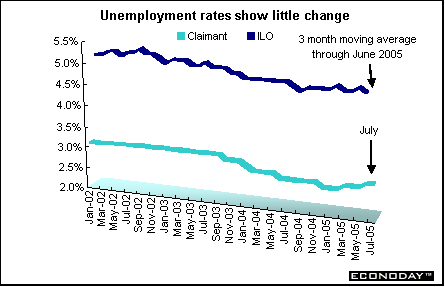
Average earnings growth for the three months to June was 4.1 percent when compared with the same three months of the previous year. Excluding bonuses, average earnings were up 4 percent.

July consumer price index was up 0.1 percent and 2.3 percent when compared with last year. This was the highest annual rate of inflation since records began in 1997 and the first time it has breached the government's 2 percent target since May 1998. Transport and furniture price increases were partially offset by lower food, recreation and culture prices. Retail price index excluding mortgage interest payments was unchanged on the month and up 2.4 percent on the year.

July retail sales volumes were down 0.3 percent but were up 1.9 percent when compared with last year. National Statistics said that it was not possible to judge the impact of the terrorist attacks on July sales data. Non-specialized stores (mainly department stores) sales dropped 2.9 percent while clothing & footwear and household goods stores declined 1.3 percent and 0.9 percent respectively.

August CBI monthly industrial trends survey showed deterioration in the manufacturing sector. The survey shows 42 percent of firms reporting total order books below normal, while 13 percent say they are above normal. The total order book balance was minus 29, its lowest level since October 2003. Export orders edged upward to minus 17 from minus 18. Output volumes declined to a positive 3 from plus 6 in July while average prices climbed to minus 8 from minus 11.
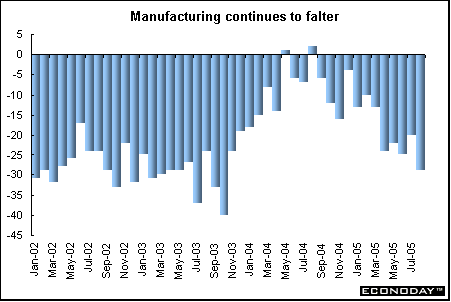
Second quarter gross domestic product was up 0.5 percent and 1.8 percent when compared with the same quarter a year ago. Services output was up 0.6 percent and 2.5 percent on the year. Manufacturing output was down 0.3 percent and dropped 1.2 percent on the year. Household spending inched up 0.2 percent and was up 1.5 percent on the year. The 1.5 percent increase was the lowest since the first quarter of 1995.

Asia
Japan - June tertiary index was up 1 percent and 2 percent when compared with last year. The tertiary index reflects activity in 11 service industries, among which are utilities; transport; telecommunications; wholesale and retail; finance and insurance; real estate; restaurants and hotels; medical, health care and welfare.

The all industry index was up 1.3 percent and 1.7 percent on the year. The all industry index takes a reading of activity in the industries that comprise the tertiary index combined with activity in the construction, agricultural and fisheries industries, the public sector and industrial output. This index is considered a close approximation for gross domestic product growth as measured by industrial and service sector output.

July seasonally adjusted merchandise trade surplus dropped to ¥604.9 billion from ¥673.3 billion in June. Exports edged up 0.1 percent while imports were up 1.5 percent. On an unadjusted basis, the merchandise trade surplus shrank by 22.5 percent from a year earlier to ¥873.6 billion. Exports were up 4.3 percent while imports increased 11.6 percent on the year. Japan's trade surplus with the U.S. was up 2.2 percent on the year while its surplus with Asia declined by 9.8 percent. Japan posted a deficit of ¥182.3 billion with China.
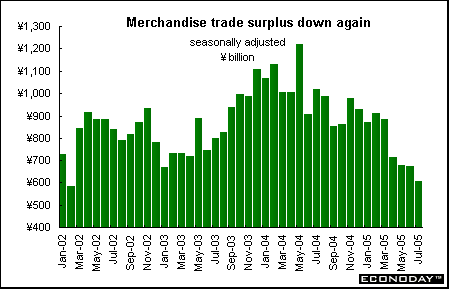
August Tokyo consumer price index was down 0.1 percent and 0.6 percent when compared with last year. The core CPI which excludes fresh food was up 0.3 percent but down 0.3 percent on the year. July nationwide CPI was down 0.1 percent and dropped 0.3 percent on the year. Record crude oil prices have prompted some manufacturers to pass climbing costs onto consumers. Dubai crude oil, a benchmark for Japanese oil refiners, has risen about 75 percent this year, touching an intraday record of $58.36 per barrel recently.
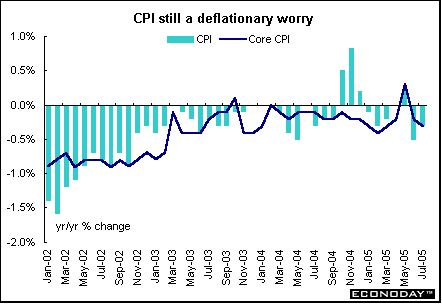
Americas
Canada - June factory shipments were up 0.5 percent and 0.7 percent when compared with last year. Excluding energy, shipments slipped by 0.1 percent. Petroleum and coal shipments were up 6.5 percent. Unfilled factory orders were up 0.7 percent and were up 7.9 percent in the 12 months ending in June. New orders were up 0.4 percent and have gained 4 percent on the year.
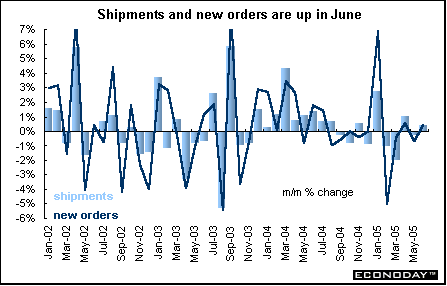
June retail sales were up 1.1 percent and 6.8 percent when compared with last year. Excluding auto and recreational vehicles, sales were up 0.4 percent and 6.5 percent on the year. Auto sales were up 2.9 percent with autos up 4.3 percent and gasoline up 1.9 percent. General merchandise, clothing and furniture and electronics were also up on the month.

July unadjusted consumer price index was up 0.2 percent and 2 percent when compared with last year. Higher gasoline prices which jumped 4 percent on the month were the main contributor to the increase in prices. Core CPI excluding food and energy dropped 0.1 percent and was up 1.1 percent on the year. The Bank of Canada core rate, which excludes eight most volatile index items, was unchanged on the month and up 1.4 percent on the year. July seasonally adjusted CPI also was up 0.2 percent and 2 percent on the year. Seasonally adjusted core CPI was unchanged on the month and up 1.1 percent on the year.

Bottom line
Vacation time is over! In the next couple of weeks, many of the major central banks will meet to consider policy. The deluge begins Thursday with the ECB's meeting. President Jean Claude Trichet will hold his first press conference in two months at the conclusion of the meeting. In the following week, the Banks of Japan, England and Canada along with the Reserve Bank of Australia will decide whether their interest rates are appropriate. And new economic data will give market players a lot of information to digest after a rather dry spell. After a rocky August, investors will anxiously watch equities to see if the slowdown turns into a trend.
Looking Ahead: August 29 through September 2, 2005
